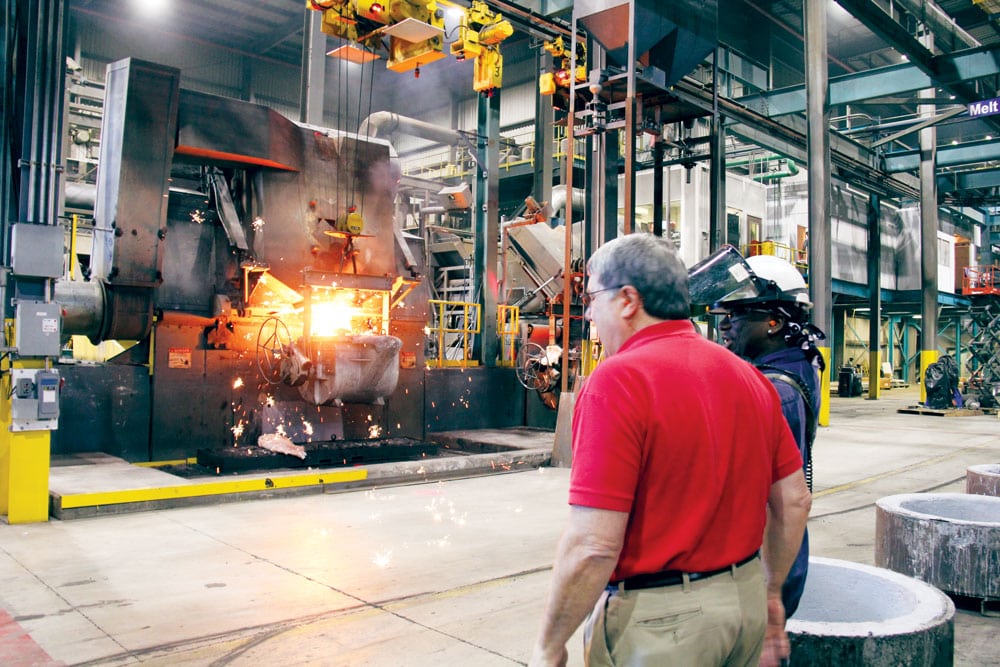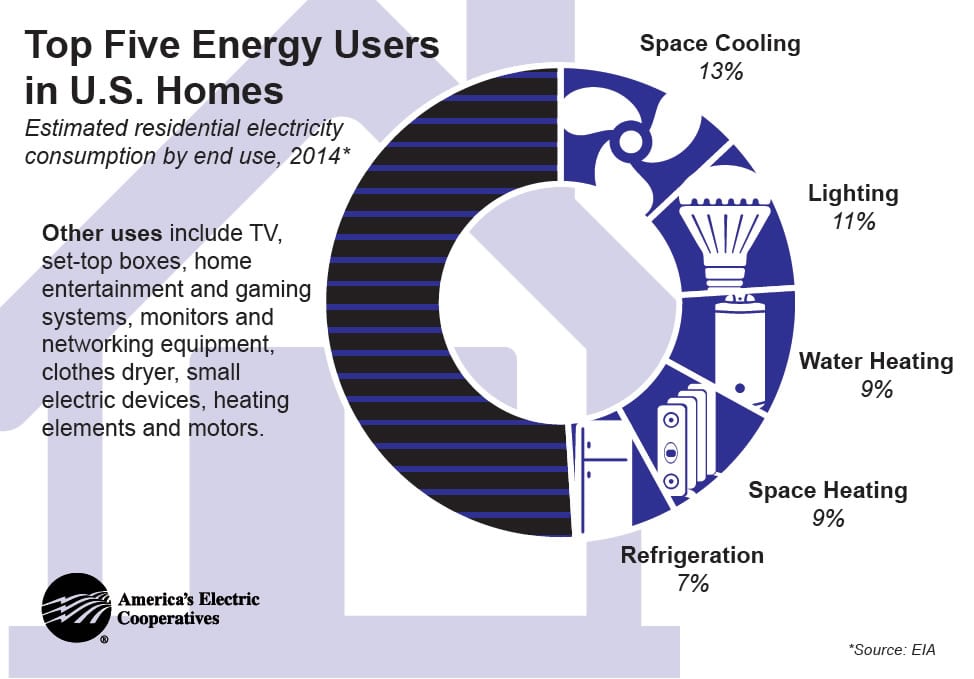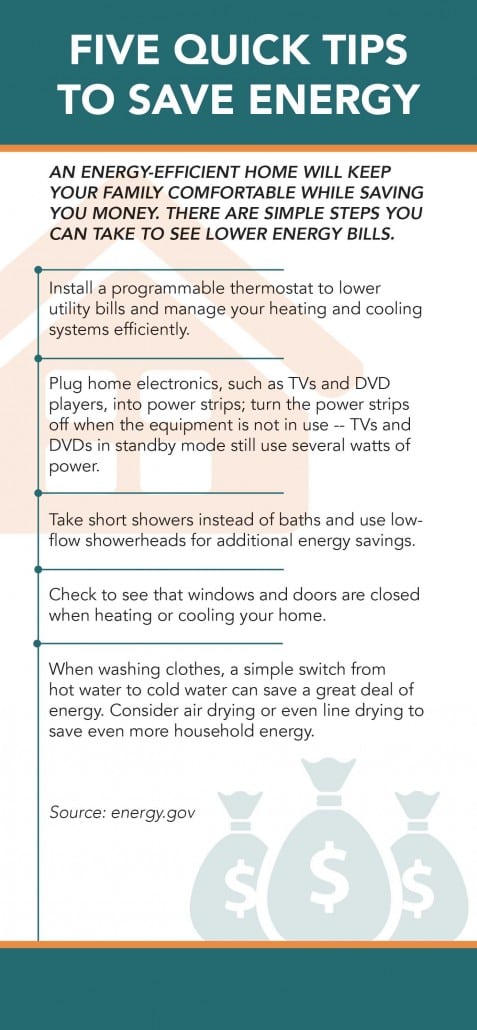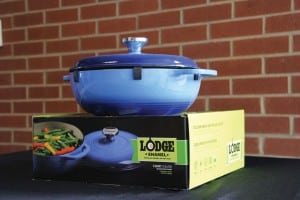Gibson EMC Board Members Steve Sanders and Rana Buchanan recently earned Director Gold Certificates through NRECA’s new certification program. Director Gold demonstrates a director’s ongoing commitment to advancing skills and knowledge. Sanders has been on the Gibson EMC board of trustees for 15 years and has served as chairman since 2014. Buchanan has been on the board for nearly 13 years. Click to learn more about Director Certification or view upcoming classes in Tennessee.
A starting point for savings
By Anne Prince
While most homeowners would like to be more energy efficient and save money, often it feels overwhelming because many people don’t know where to start. How can the average family use less energy, lower their utility bill and still meet their daily energy needs? To help jumpstart your effort, it is useful to know what the top energy users are in your home. With this knowledge, you can choose a path that works best for your family.
According to the U.S. Energy Information Agency, the top five energy users in U.S. homes are:
- Space cooling
- Space heating
- Water heating
- Lighting
- Refrigeration
Adjust the temperature
Together, home heating and cooling use the most energy and take the biggest bite out of your energy budget. On the bright side, there are ways you can achieve at least 10 percent savings by taking a few simple low-cost or no-cost steps.
- During cold weather, set your thermostat to 68 degrees Fahrenheit.
- During warm weather, the recommended indoor temperature is 78 degrees Fahrenheit.
- Cleaning the filters of your HVAC system can cut costs from five to 15 percent.
- Clean the coils around your electric baseboard heater to maintain maximum efficiency.
- Caulk and weather-strip around windows and doors to prevent heat from escaping to the outdoors.
No matter what the climate or time of year, proper use of a programmable thermostat can save you 10 percent on your monthly utility bill.
Shine the light on savings
Take a fresh look at the lighting in your home. If you still use incandescent lighting, your light bulbs are operating at only 25 percent energy efficiency. Replacing your home’s five most frequently used bulbs with Energy Star-certified LEDs can save you $75 per year. Another easy way to save is to always turn lights off in rooms that are not being used.
Water heating efficiency
Just as it is energy-wise to insulate your roof, wall or floor, it also pays to wrap your hot water heater with an insulating blanket. This is all the more critical if you have an older unit. Make sure to follow the manufacturer’s instructions. For additional efficiency and savings, insulate exposed hot water lines and drain one to two gallons of water from the bottom of your tank annually to prevent sediment build-up.
Put cold hard cash back in your wallet
If your refrigerator was purchased before 2001, chances are it uses 40 percent more energy than a new Energy Star model. If you are considering an appliance update, a new Energy Star refrigerator uses at least 15 percent less energy than non-qualified models and 20 percent less energy than required by current federal standards. Regardless of the age of your fridge, there are additional steps you can take to save energy and money. For example, don’t keep your refrigerator too cold. The Department of Energy recommends temperatures of 35 – 38 degrees Fahrenheit for the fresh food compartment and 0 degrees Fahrenheit for separate freezers (used for long-term storage).
By understanding how your home uses energy, you can determine the best ways to modify energy use and keep more money in your wallet. For additional ways to save, visit our energy page or contact your local electric cooperative.
Anne Prince writes on consumer and cooperative affairs for the National Rural Electric Cooperative Association, the Arlington, Va.-based service arm of the nation’s 900-plus consumer-owned, not-for-profit electric cooperatives.
Until recently, homes were lit with a single technology—incandescent lamps. This is the bulb that generations of Americans learned by, lived by—and even ate by. But those days are long gone.
Over the past 20 years, electric co-ops have promoted efficient lighting by adding CFLs to the mix. In 2012, about 30 percent of U.S. residential sockets were filled with CFLs, with incandescents making up the remaining 70 percent. Today, LED bulbs and fixtures are increasingly preferred in many residential and commercial applications for their efficiency, quality of light and compatibility with automatic controls.
Changes to federal lighting standards went into effect for incandescent bulbs in 2007, when Congress passed and President George W. Bush signed the Energy Independence and Security Act of 2007 (EISA), which included provisions to reduce the energy use of everyday light bulbs.
At the same time, through industry efforts and government investment, LEDs dramatically improved in performance and dropped in price, making them appealing options for many applications.
In the first quarter of 2015, traditional incandescents accounted for just nine percent of the market share in household lighting. EISA-compliant halogen incandescent replacements made up more than 44 percent of the market, with CFLs at 40 percent. And although the percentage of LED sales has increased dramatically over the last year, they made up just over 6 percent of the market share in the first quarter of 2015.
LEDs offer features beyond energy efficiency. Some LEDs are part of a system that allows the user to turn off lamps – or even change their color – via a smartphone app. This makes the LED lamp more of a consumer electronic than just a light bulb.
LEDs are essentially computer chips, so they are more difficult to produce than incandescent bulbs. This is one product where cheaper versions often produce a life span and color that is not what the consumer wants. Higher quality LEDs from reputable brands—such as GE, Philips, Cree and Sylvania to name a few—have tested well.
However, some fixtures inside the home do not work well with LEDs. Consumers with older dimmer switches often find that they must purchase newer switches to work with the LEDs. Consumers should pick LED lamps that come with a solid warranty in case there is a problem with quality.
What’s next? While LEDs are still on the cusp of becoming our everyday lighting, there are other technologies in development. Organic Light Emitting Diodes (OLEDs) are similar to LEDs in that they are solid-state devices that produce light when current passes through them. But unlike LEDs, they are made up of multiple, organic semi-conductive layers that produce diffused light. OLEDs are extremely thin and flexible, which has enabled them to be effectively used in displays, like mobile phone screens and TVs. Manufacturers are developing OLED lighting as well—primarily for decorative architectural panels at this point, although some OLED lamps are available today.
It appears that the age of the LED has begun. They are shatter resistant and have a long life. And yes, some even come with their own app.
Brian Sloboda is a program manager specializing in energy efficiency for the National Rural Electric Cooperative Association.
Laura Moorefield consults for utilities, state and federal governments, and non-profits on energy efficiency, renewables, and program design. Laura founded Moorefield Research & Consulting, LLC in 2013. She currently resides in Durango, CO and is a member of La Plata Electric Association.
120 Years Strong and Growing
Since 1896, Lodge Manufacturing has been an important economic force in South Pittsburg. And even in an age of fast-food and planned obsolescence, the cast-iron cookware standard-bearer continues to grow and become stronger than ever.
You would think that when you produce a product that never wears out and is passed down from generation to generation, you would finally work yourself out of a job. However, cast-iron cookware is experiencing a new surge in popularity fueled by cooking programs on television, food bloggers on the Internet and the “sharing” of all things “foodie” on social media sites such as Pinterest, Facebook and Twitter.
The demand for cast-iron cookware, highly touted for its ability to evenly conduct heat and its natural nonstick qualities, has forced Lodge Manufacturing to get into what company President/Chief Operating Officer Henry Lodge calls “hurry-up” mode to meet the surging demand.
“We have always planned five to 10 years out, but as we watched the demand beginning to increase and started working toward expansion, we found that we had outgrown our plan before we could even implement it,” Lodge stated. “About five years ago, we realized we would need additional product to meet the growing demand. We thought we would have about five years to meet the projected growth, but before we could actually start building the new foundry, we realized that as soon as it was built, it would be filled up. Sales had grown more than we had expected or planned.”
The recent expansion project included entirely new melting furnaces, a new Disamatic molding machine — much larger than the old one — a whole new sand system and new cleaning, finishing and packaging facilities.
“The new melting system came on-line in 2013, the new production and molding equipment in 2014,” Lodge said. “Even with all the new equipment, we still can’t keep up with the market. It is growing faster than we can produce.”
Market numbers show that sales of cast-iron cookware have increased from 4 percent to 10 percent of the cookware market. So even though people hold on to their heirloom skillets, they love their cast iron so much they are adding griddles, Dutch ovens and other pieces to their collections.
One factor to which Lodge attributes the popularity of their line is the fact that the cookware comes already “seasoned.” The care of cast iron has been seen as daunting or just “too much trouble.” However, that changed when Lodge introduced its “Logic” preseasoned pieces in 2002. The line was so popular that soon all of Lodge’s cookware left the factory seasoned.
With nearly 300 employees, Lodge is one of the largest employers in Marion County, so its growth, expansion and climbing sales figures mean a better economy for the county and the Sequatchie Valley.
“We are moving a LOT of product,” Lodge said. “We produce the largest selection of American-made cast-iron cookware, although there are a couple of small niche companies that produce small quantities of high-end ‘designer’ cookware here in the U.S.

Henry Lodge, left, Lodge Manufacturing president/chief operating officer, talks with Larry Pines, operator of a new, more-efficient, electric melting furnace, during a walk-through of the company’s newly rebuilt foundry.
“Our products are sold in retail stores such as Wal-Mart, Target, Cracker Barrel, Williams-Sonoma, Cabela’s and Bass Pro Shops as well as Amazon. We even ship to a number of foreign countries but that only makes up about 10 percent of our sales. We haven’t really pushed the foreign markets because we are fighting to keep up with American sales.”
The 120-year-old family-owned business, now run by Lodge and CEO Bob Kellerman,great-grandsons of founder Joseph Lodge, is making plans for the next five to 10 years and beginning work on the next building project — a new warehouse across the river in New Hope — while settling into the new, larger factory store in South Pittsburg.
“A large part of our being here — keeping the business local — is to help make South Pittsburg, Marion County and the Sequatchie Valley a great place to live and work and to continue to provide families with opportunities,” Lodge said. “I can’t talk about our success without talking about our people. This growth and success are only possible because we have great employees producing great products for our customers.”
“Lodge Manufacturing has been a good corporate citizen from the beginning,” said Mike Partin, Sequachee Valley Electric Cooperative president/CEO. “The company’s commitment to the community and its employees is evident in everything it does. This was demonstrated by the leadership R.L. Lodge gave in bringing electricity to the rural areas of the Sequatchie Valley and the surrounding mountains as the first chairman of the SVEC board of directors. It continues today with the leadership and support that Bob Kellerman and Henry Lodge and their team have given to community projects such as the National Cornbread Festival, which brings tens of thousands of visitors to South Pittsburg each year, boosting the local economy. Lodge Manufacturing is a long-time sponsor of the local Boy Scout troop and supports countless other local causes and events. SVEC is proud to be a partner and power supplier to such an outstanding community asset. Partnerships like this are what make our communities Co-op Strong.”
Question: What do you do for a living?
Answer: I can tell you, but I’d have to kill you.
We’re not secret agents, but we do have more knowledge than the general public about cyber security concerns. We work hard to mitigate fear mongering and any sense of panic among our members.
At the same time, we need to be cognizant of the dangers of cyber theft and malicious intrusions from hackers – both in our ability to manage the grid and maintaining the privacy of our members.
In rural America, the distance between substations, even between members, can be significant. The electronic devices that we use and how we access them allow us to know when disruptions occur and to quickly respond. As the use of technology becomes more prevalent and increasingly complex, the risk of security breaches grows.
“We have in our minds the picture of a hacker as some 15-year-old in his parents’ basement. That used to be the case but it’s not now. Hackers are bots hitting 10 million systems at once, just looking for a vulnerability,” says Bill West, vice president of underwriting at Federated Rural Electric Insurance Exchange. He also adds, “The average cyber insurance claim costs $733,000.”
Any information technology expert that is involved in cyber security will confirm that attacks are frequent. We know this from the industry reports we read. Data breaches can expose the private information of our members and should hackers gain access to control systems, they could disrupt power flow. Throwing a political tilt into cyber issues, hacker attacks are often from foreign countries.
Across the nation, electric cooperatives are participating at every level – from local, regional and national exercises to legislative improvements that affect information sharing between governmental agencies and utilities. (S. 754, in which electric cooperatives had input)
We recognize that because we are rural and comparatively small, it doesn’t mean that we are at less risk than large utilities. As Deputy Energy Secretary Elizabeth Sherwood Randall said last year, “If we don’t protect the energy sector, we are putting every other sector of the economy in peril.”
Let’s make certain that we take cyber security as seriously as we take keeping the lights on. It’s just one more thing to add to our “To Do” list.

Tennessee Electric Cooperative Association
2964 Sidco Drive, Nashville, TN 37204
Phone : 615.367.9284



